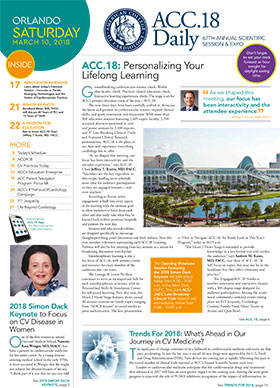Bishop Keynote: In PCI, New Does Not Equal Better
Through chance, a young physician, Bernhard Meier, MD, FACC, participated in a historic event — the first PCI procedure — on Sept. 16, 1977. Assisting Andreas R. Gruentzig, MD, FACC, in a groundbreaking medical procedure introduced Meier to a world of innovation. But the ensuing 40 years have taught him that new is not necessarily better.
“I’ve been kind of a maverick in the field. I still follow in Gruentzig’s footsteps, though, and have kept his dictum that things should stay simple,” says Meier. As PCI developed in various directions, Meier scrutinized these innovations, but he was reluctant about replacing balloon angioplasty.
When Meier delivers the Louis F. Bishop Keynote today, he will reflect on the positive developments in PCI, including transcatheter aortic valve replacement (TAVR) – “the best thing that came out of PCI.” Meier also promises to stir the pot by critiquing PCI developments he considers superfluous.
"Explore to the maximum what you can do with a simple catheter-based intervention that can even be done as an outpatient procedure. Don’t try to make things more complicated than they need to be." — Bernhard Meier, MD, FACC
“Now there are a lot of inventors around the world who want a share of the prestige, but also the revenue that may come from creating something new. There were a lot good but also a few really bad things that were introduced,” says Meier, who is the professor and chairman of cardiology at University Hospital, Bern, Switzerland.
As a medical school graduate in Zurich in 1977, Meier began working in the specialty of angiology when Gruentzig had just developed the first balloon catheter to open occluded vessels in legs. Gruentzig’s goal was to miniaturize the balloons and use them in patients with coronary artery disease. He needed a patient who was a good candidate for the first procedure. Meier was treating such a young patient.
“It was serendipity that I found the first patient. He’s doing well and just turned 79,” Meier says. “I introduced him to Gruentzig who explained there was an alternative to coronary artery bypass surgery.”
Meier says he worked in the shadow of Gruentzig until 1985, when the PCI pioneer died in a plane crash. In those years, steerable guidewires and smaller catheters were developed to improve PCI procedures.
“In 1986, the first modern stent was implanted, which I immediately thought was big progress,” Meier notes. The drug-eluting stent came in 2002. “That was important progress. But for me, that was about it. I thought that was all we needed.” He says there was good equipment, catheters with balloons to go through the narrowing and drug-eluting stents. “I am still performing these procedures, and that is basically what I use,” he adds.
Other PCI advances, such as lasers, directional atherectomy, absorbable stents, the use of fractional flow reserve and some imaging technologies, do not fare so well in his eyes. “In my opinion, unnecessary things are still used in millions of people around the world. I’m one of the few people who have admonished my colleagues for using all of this when you can get the same result without it,” Meier says. “I’m kind of going against what I call ‘myths in PCI.’ I’m sure that will keep the audience awake but will not get a lot of cheers. I’m used to that.”
Meier also will examine the development of TAVR, whose use he favors over open heart surgery also in low-risk patients. TAVR is a continuation of the “simpler is better” approach he has followed for decades. “PCI is great. TAVR is great,” Meier says. “Explore to the maximum what you can do with a simple catheter-based intervention that can even be done as an outpatient procedure. Don’t try to make things more complicated than they need to be.”
The 49th Annual Louis F. Bishop Keynote will take place today from 12:15 – 1:45 p.m. in Main Tent, Hall C.
Keywords: ACC Publications, ACC Scientific Session Newspaper, ACC Annual Scientific Session
< Back to Listings

